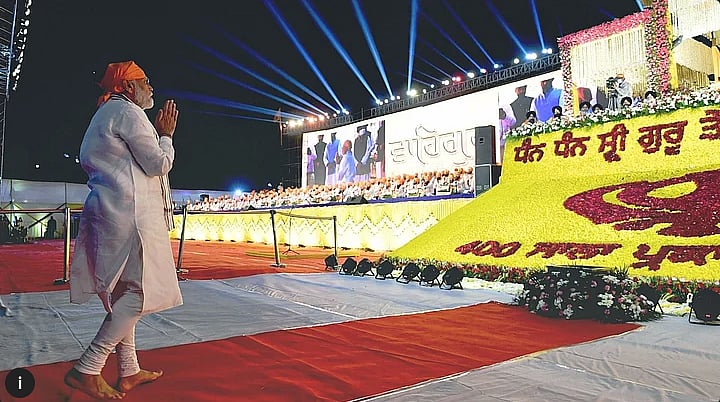Guru Tegh Bahadur Died Fighting Communal Hatred That the BJP-RSS Promote Today
Guru Tegh Bahadur’s religious vision was to stand for the rights of the oppressed.

advertisement
(The Quint has consistently been the leading news organisation breaking stories on communal violence and hate crimes and carrying out in-depth investigations on communal issues. These investigations involve a lot of work and often come at great personal risk to our reporters who are on the ground. We need your support as we continue to bring out more such investigations and voices from the ground. BECOME A MEMBER and support us!)
As Sikhs around the globe and in India are ready to commemorate Guru Tegh Bahadur’s 350th Martyrdom Anniversary, I remember the Salok from Guru Tegh Bahadur’s Baani:
"ਭੈ ਕਾਹੂ ਕਉ ਦੇਤ ਨਹਿ ਨਹਿ ਭੈ ਮਾਨਤ ਆਨ ॥"
(“One who does not frighten anyone, and who is not afraid of anyone else.”)
Its meaning in contemporary times, especially in the current political environment, is urgent. There is a strong need to understand Guru Tegh Bahadur and his supreme sacrifice for human rights, freedom of self-expression, and the right to practise one’s own religion.
The Indian government and the Delhi government have started various programmes to commemorate this event. There is talk of renaming the Delhi Railway Station to Guru Tegh Bahadur Railway Station. There have also been suggestions to write Saloks on trains and at railway stations. The Delhi government is hosting a three-day Kirtan Darbar at the Red Fort, near Chandni Chowk, where Guru Tegh Bahadur was beheaded on the orders of Aurangzeb to protect the religious freedom of Kashmiri Pandits.
The Guru Who Refused to Bow Down to Tyranny
Guru Tegh Bahadur, the Ninth Sikh Guru, was the son of the Sixth Guru, Guru Hargobind Sahib, and the father of the Tenth Guru, Guru Gobind Singh. He spent his life teaching compassion, religious harmony, and spirituality.
Guru Tegh Bahadur was born in Amritsar in 1621. He received his education and training under Guru Hargobind. In 1635, he fought in the Battle of Kartarpur, and because of his bravery and exceptional swordsmanship, Guru Hargobind changed his name from Tyag Mal to Tegh Bahadur.
A delegation of around 500 Kashmiri Pandits, led by Pandit Kirpa Ram Dutt, met Guru Tegh Bahadur at Anandpur Sahib and sought his protection. They informed him about the oppressive and violent policies of Aurangzeb. Guru Tegh Bahadur then told them to convey a message to Aurangzeb: to convert their Guru first. Afterwards, he was arrested on the orders of Aurangzeb with his companions, Bhai Mati Das, Bhai Sati Das, and Bhai Dayala, and they were tortured and were asked to convert to Islam or die.
Guru Tegh Bahadur, along with his companions, chose martyrdom rather than bowing to tyranny. Pandit Kirpa Ram Dutt, who later became Kirpa Singh after joining the Khalsa, sacrificed his life in the Battle of Chamkaur.
History matters today because the patterns of state power and persecution based on religious lines continue to be our present.
Guru Teg Bahadur's Relevance in Today's India
As we remember Aurangzeb’s tyranny, we also see how the contemporary state functions in similar ways. Political prisoners like Umar Khalid, Sharjeel Imam, Gulfisha Fatima, Meeran Haider, and Shifa-ur-Rehman continue to remain behind bars, reflecting how dissent is criminalised.
Recently, the UP government filed a petition to withdraw the Akhlaq lynching case after 10 years. Akhlaq was lynched in his own home in Dadri, and even after a decade his family still awaits justice. This shows how the state not only protects the murderers but also fails to deliver justice to Sikh and Muslim political prisoners who have been languishing in jail for years. Many Sikh prisoners have even completed their sentences, yet continue to remain incarcerated. This demonstrates how the political and justice systems are used as tools against minorities to control and suppress their rights.
Even after the Red Fort blast case, all Kashmiris were labelled as terrorists, and the “godi media” communalised the issue and villainised Muslims with terms like “MBBS jihad”.
The BJP remembers Guru Tegh Bahadur only because it fits its anti-Muslim narrative. Since Aurangzeb was a Muslim ruler, and Guru Tegh Bahadur sacrificed his life to protect the religious freedom of Hindus, the narrative is used to further villainise Indian Muslims. Guru Tegh Bahadur stood against the same communal environment and bigotry that the BJP/RSS government promotes today.
In recent years, the BJP has celebrated the sacrifices of Guru Gobind Singh and his sons, declaring Veer Bal Diwas in honour of the Char Sahibzaade. The same supporters who call Sikhs “Khalistani” when they oppose the BJP’s communal agenda now celebrate Sikh heroism because it serves their political narrative.
The idea of religion is to protect, to show compassion, not to spread hatred. Guru Tegh Bahadur’s religious vision was to stand for the rights of the oppressed.
In today’s reality, if we truly want to understand the message of the Guru, we must look inward and ask: what kind of religious person are we? The one who stands for truth and justice — or the one who spreads hate in the name of religion? To truly celebrate Guru Tegh Bahadur’s 350th martyrdom anniversary, we must understand what he taught, not merely repeat his name. To remember Guru Tegh Bahadur is to remember the individual’s right to self-expression, dignity, and religious freedom — the very principles for which he gave his life.